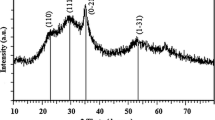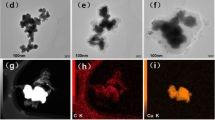Abstract
In this paper, novel three-dimensional (3D) CuO precursor was synthesized under the ice water bath. The flower-like micellar polyp-phenylenediamine (PpPD) was synthesized when the p-phenylenediamine–salicylic acid ([SA]/PPD) ratio was 1:1. The two amino groups of PpPD interacted with Cu2+ by the coordination interactions. After calcination in the air, dandelion-like CuO nanoflowers were successfully prepared. The physicochemical properties of the as-prepared CuO were characterized by scanning electron microscopy (SEM), transmission electron microscopy (TEM), X-ray diffraction (XRD), infrared spectrometer (FT-IR), UV–vis absorption spectra (UV–vis), and energy-dispersive spectrometer (EDS). In the participation of H2O2, the as-obtained CuO nanoflowers exhibited high efficiency on the decolorization of rhodamine B (RhB) by the synergy of ·OH and ·O2 −. The novel dandelion-like CuO also provided more active sites to improve the photocatalytic effect. It can be applied to the degradation of dyes, such as RhB, and plays a role in environmental pollution control.








Similar content being viewed by others
References
Khanna PK, Gaikwad S, Adhyapak PV, Singh N, Marimuth R (2007) Synthesis and characterization of copper nanoparticles Mater Lett 61:4711–4714
Shrestha KM, Sorensen CM, Klabunde KJ (2010) Synthesis of CuO nanorods, reduction of CuO into Cu nanorods, and diffuse reflectance measurements of CuO and Cu nanomaterials in the near infrared region J Phys Chem C 114:14368–14376
Noorman S, Gallucci F, Annaland MS, Kuipers HJAM (2010) Experimental investigation of a CuO/Al2O3 oxygen carrier for chemical-looping combustion Ind Eng Chem Res 49:9720–9728
Hossain MM, Lasa HI (2008) Chemical-looping combustion (CLC) for inherent CO2 math container loading Mathjax separations—a review Chem Eng Sci 63:4433–4451
Zhu GX, Xu H, Xiao YY, Liu YJ, Yuan AH, Shen XP (2012) Facile fabrication and enhanced sensing properties of hierarchically porous CuO architectures ACS Appl Mater Interfaces 4:744–751
Gao SY, Yang SX, Shu J, Zhang SX, Li ZD, Jiang K (2008) Green fabrication of hierarchical CuO hollow micro/nanostructures and enhanced performance as electrode materials for lithium-ion batteries J Phys Chem C 112:19324–19328
Sung SY, Kim SY, Jo KM, et al. (2010) Fabrication of p-channel thin-film transistors using CuO active layers deposited at low temperature Appl Phys Lett 97:222109–222109-3
Kim SJ, Hong KY, Kim KS, Lee I, Kim K-B, Lee DY, Kim T-Y, Lee J-L (2010) Hole injection layer of thermally evaporated copper oxide for top emitting organic light emitting diodes sensors and displays: principles, materials, and processing J Electrochem Soc 157:J347–J350
Yang ZH, Xu J, Zhang WX, Liu AP, Tang SP (2007) Controlled synthesis of CuO nanostructures by a simple solution route J Solid State Chem 180:1390–1396
Lanza F, Feduzi R, Fuger JJ (1990) Effects of lithium oxide on the electrical properties of CuO at low temperatures J Mater Res 5:1739–1744
Gao XP, Bao JL, Pan GL, Zhu HY, Huang PX, Wu F, Song DY (2004) Preparation and electrochemical performance of polycrystalline and single crystalline CuO nanorods as anode materials for Li ion battery J Phys Chem B 108:5547–5551
Zheng SF, Hu JS, Zhong LS, Song WG, Wan LJ, Guo YG (2008) Introducing dual functional CNT networks into CuO nanomicrospheres toward superior electrode materials for lithium-ion batteries Chem Mater 20:3617–3622
Reddy MV, Yu C, Fan JH, Loh KP, Chowdari BVR (2013) Li-cycling properties of molten salt method prepared nano/submicrometer and micrometer-sized CuO for lithium batteries ASC Appl Mater Interfaces 5:4361–4366
Poizot P, Laruelle S, Grugeon S, Dupont L, Tarascon JM (2000) Nano-sized transition-metal oxides as negative-electrode materials for lithium-ion batteries Nature 407:496–499
Raj DMA, Raj AD, Irudayaraj AA (2014) Facile synthesis of rice shaped CuO nanostructures for battery application J Mater Sci Mater Electron 25:1441–1445
Chaudhary GR, Bansal P, Kaur N, Mehta SK (2014) ChemInform abstract: recyclable CuO nanoparticles as heterogeneous catalysts for the synthesis of xanthenes under solvent free conditions RSC Adv 46:49462–49470
Xiao W, Wang DL, Lou XW (2010) Shape-controlled synthesis of MnO2 nanostructures with enhanced electrocatalytic activity for oxygen reduction J Phys Chem C 114:1694–1700
Zhu YC, Mei T, Wang Y, Qian Y (2011) Formation and morphology control of nanoparticles via solution routes in an autoclave J Mater Chem 21:11457–11463
Xu L, Lu CL, Zhang ZH, Yang X, Hou W (2010) Various self-assembled three-dimensional hierarchical architectures of La2(MoO4)3: controlled synthesis, growth mechanisms, luminescence properties and adsorption activities Nano 2:995–1005
Xie XW, Li Y, Liu ZQ, Haruta M, Shen W (2009) Low-temperature oxidation of CO catalysed by Co3O4 nanorods Nature 458:746–749
Yang HG, Sun CH, Qiao SZ, Zou J, Liu G, Smith SC, Cheng HM, Lu GQ (2008) Anatase TiO2 single crystals with a large percentage of reactive facets Nature 453:638–641
Maeda T, Kobayashi Y, Yasuda Y, Morita T (2015) Low-temperature metal–metal bonding process using leaf-like aggregates composed of CuO nanoparticles J Chem Eng Jpn 48:1–6
Mahmoud N, Mohammad SS, Mehdi M (2015) Tamarix gallica leaf extract mediated novel route for green synthesis of CuO nanoparticles and their application for N-arylation of nitrogen-containing heterocycles under ligand-free conditions RSC Adv 5:40628–40635
Jiang LC, Zhang WD (2010) A highly sensitive nonenzymatic glucose sensor based on CuO nanoparticles-modified carbon nanotube electrode Biosens Bioelectron 25:1402–1407
Aminuzzaman M, Kei LM, Liang WH (2017) Green synthesis of copper oxide (CuO) nanoparticles using banana peel extract and their photocatalytic activities Green Sustain Technol 1828:020016-1–020016-5
Xue BW, Qian ZW, Liu CS, Luo GX (2017) Synthesis of CuO nanoparticles via one-pot wet-chemical method and its catalytic performance on the thermal decomposition of ammonium perchlorate1 Russ J Appl Chem 90:138–143
Kumar A, Srivastava AK, Tiwari P, Nandedkar RV (2004) The effect of growth parameters on the aspect ratio and number density of CuO nanorods J Phys Condens Matter 16:8531–8543
Zhang XJ, Shi WH, Zhu JX, Kharistal DJ, Zhao WY, Lalia BS, Hng HH, Yan QY (2011) High-power and high-energy-density flexible pseudocapacitor electrodes made from porous CuO nanobelts and single-walled carbon nanotubes ACS Nano 5:2013–2019
Zhang XJ, Yu LT, Wang LL, Ji R, Wang GF, Geng BY (2013) High electrochemical performance based on ultrathin porous CuO nanobelts grown on Cu substrate as integrated electrode Phys Chem Chem Phys 15:521–525
Lugo-Ruelas M, Amézaga-Madrid P, Esquivel-Pereyra O, Antúnez-Flores W, Pizá-Ruiz P, Ornelas-Gutiérrez C, Miki-Yoshida M (2015) Synthesis, microstructural characterization and optical properties of CuO nanorods and nanowires obtained by aerosol assisted CVD J Alloys Compd 643:S46–S50
Liu B, Zeng HC (2004) Mesoscale organization of CuO nanoribbons: formation of “dandelions” J Am Chem Soc 126:8124–8125
Sharma JK, Akhtar MS, Ameen S, Srivastava P, Singh G (2015) Green synthesis of CuO nanoparticles with leaf extract of Calotropis gigantea and its dye-sensitized solar cells applications J Alloys Compd 632:321–325
Yu XY, Xu RX, Gao C, Luo T, Jia Y, Liu JH, Huang XJ (2012) Novel 3D hierarchical cotton-candy-like CuO: surfactant-free solvothermal synthesis and application in As(III) removal ACS Appl Mater Interfaces 4:1954–1962
Chang TH, Hsu CY, Lin HC, Chang KH, Li YY (2015) Formation of urchin-like CuO structure through thermal oxidation and its field-emission lighting application J Alloys Compd 644:324–333
Tang CM, Liao XY, Zhong WJ, Yu HY, Liu ZW (2017) Electric field assisted growth and field emission properties of thermally oxidized CuO nanowires RSC Adv 7:6439–6446
Fujiwara M, Terashima S, Endo Y, Shiokawa K, Ohue H (2006) Switching catalytic reaction conducted in pore void of mesoporous material by redox gate control Chem Commun 44:4635–4637
Yang PP, Quan ZW, Li CX, Lian HZ, Huang SS, Lin J (2008) Fabrication, characterization of spherical CaWO4:Ln @MCM-41(Ln = Eu3+, Dy3+, Sm3+, Er3+) composites and their applications as drug release systems Microporous Mesoporous Mater 116:524–531
Gierszal KP, Jaroniec MJ (2007) Large pore volume carbons with uniform mesopores and macropores: synthesis, characterization, and relations between adsorption parameters of silica templates and their inverse carbon replicas J Phys Chem C 111:9742–9748
Fan R, Huh S, Yan RX, Arnold J, Yang PD (2008) Gated proton transport in aligned mesoporous silica films Nat Mater 7:303–307
Duan YY, Liu X, Han L, Asahina S, Xu D, Cao Y, Yao Y, Che S (2014) Optically active chiral CuO “nanoflowers” J Am Chem Soc 136:7193–7196
Song MJ, Hwang SW, Whang D (2010) Non-enzymatic electrochemical CuO nanoflowers sensor for hydrogen peroxide detection Talanta 80:1648–1652
Gao DQ, Zhang J, Yang GJ, Zhang JL, Shi ZH, Qi J, Zhang ZH, Xue DS (2010) Ferromagnetism in ZnO nanoparticles induced by doping of a nonmagnetic element: Al J Phys Chem C 114:18347–18351
Manna S, Das K, De SK (2010) Template-free synthesis of mesoporous CuO dandelion structures for optoelectronic applications ACS Appl Mater Interfaces 2:1536–1542
Vinogradov VV, Agafonov AV, Vinogradov AV (2009) Application of polyethyleneimine to obtain a mesoporous CuO–Al2O3 composite Mendeleev Commun 19:222–223
Zhang LJ, Wan MX (2003) Self-assembly of polyaniline—from nanotubes to hollow microspheres Adv Funct Mater 13:815–820
Gupta R, Sanotra S, Sheikh HN, Kalsotra BL (2013) Room temperature aqueous phase synthesis and characterization of novel nano-sized coordination polymers composed of copper(II), nickel(II), and zinc(II) metal ions with p-phenylenediamine (PPD) as the bridging ligand J Nanostruct Chem 3:41–49
Umadevi M, Christy AJ (2013) Synthesis, characterization and photocatalytic activity of CuO nanoflowers Spectrochim Acta A Mol Biomol Spectrosc 109:133–137
Wang LJ, Zhou Q, Zhang GL, Liang YJ, Wang BS, Zhang WW, Lei B, Wang WZ (2012) A facile room temperature solution-phase route to synthesize CuO nanowires with enhanced photocatalytic performance Mater Lett 74:217–219
Wang WZ, Wang LJ, Shi HL, Liang YJ (2012) A room temperature chemical route for large scale synthesis of sub-15 nm ultralong CuO nanowires with strong size effect and enhanced photocatalytic activity Cryst Eng Comm 14:5914–5922
Isarain-Chavez E, Garrido JA, Rodríguez RM, Centellas F, Arias C, Cabot PL, Brillas E (2011) Mineralization of metoprolol by electro-Fenton and photoelectro-Fenton processes J Phys Chem A 115:1234–1242
Zhu PF, Li J, Zuo SF, Zhou RX (2008) Preferential oxidation properties of CO in excess hydrogen over CuO-CeO2 catalyst prepared by hydrothermal method Appl Surf Sci 255:2903–2909
Zhang XJ, Wang GF, Liu XW, Wu HQ (2008) Synthesis and electrochemical properties of CuO nanobelts Mater Chem Phys 112:726–729
Acknowledgements
This work was supported by the Key Fund Project of the Sichuan Provincial Department of Education (14ZA0125) and the National College Students’ innovation project training plan (201510638040).
Author information
Authors and Affiliations
Corresponding author
Ethics declarations
Conflict of interest
The authors declare that they have no conflict of interest.
Rights and permissions
About this article
Cite this article
Duan, L., Yin, S., Li, M. et al. The synthesis of dandelion-like CuO nanoflowers and photocatalytic degradation of RhB. Colloid Polym Sci 295, 1797–1803 (2017). https://doi.org/10.1007/s00396-017-4157-y
Received:
Revised:
Accepted:
Published:
Issue Date:
DOI: https://doi.org/10.1007/s00396-017-4157-y




